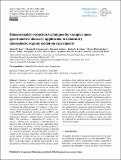| dc.contributor.author | Koss, Abigail R. | |
| dc.contributor.author | Nihill, Kevin J. | |
| dc.contributor.author | Lim, Christopher Yung-Ta | |
| dc.contributor.author | Rowe, James Clifford. | |
| dc.contributor.author | Kroll, Jesse | |
| dc.date.accessioned | 2020-06-02T16:51:03Z | |
| dc.date.available | 2020-06-02T16:51:03Z | |
| dc.date.issued | 2020-01 | |
| dc.identifier.issn | 1680-7316 | |
| dc.identifier.uri | https://hdl.handle.net/1721.1/125614 | |
| dc.description.abstract | Oxidation of organic compounds in the atmosphere produces an immensely complex mixture of product species, posing a challenge for both their measurement in laboratory studies and their inclusion in air quality and climate models. Mass spectrometry techniques can measure thousands of these species, giving insight into these chemical processes, but the datasets themselves are highly complex. Data reduction techniques that group compounds in a chemically and kinetically meaningful way provide a route to simplify the chemistry of these systems but have not been systematically investigated. Here we evaluate three approaches to reducing the dimensionality of oxidation systems measured in an environmental chamber: positive matrix factorization (PMF), hierarchical clustering analysis (HCA), and a parameterization to describe kinetics in terms of multigenerational chemistry (gamma kinetics parameterization, GKP). The evaluation is implemented by means of two datasets: synthetic data consisting of a three-generation oxidation system with known rate constants, generation numbers, and chemical pathways; and the measured products of OH-initiated oxidation of a substituted aromatic compound in a chamber experiment. We find that PMF accounts for changes in the average composition of all products during specific periods of time but does not sort compounds into generations or by another reproducible chemical process. HCA, on the other hand, can identify major groups of ions and patterns of behavior and maintains bulk chemical properties like carbon oxidation state that can be useful for modeling. The continuum of kinetic behavior observed in a typical chamber experiment can be parameterized by fitting species' time traces to the GKP, which approximates the chemistry as a linear, first-order kinetic system. The fitted parameters for each species are the number of reaction steps with OH needed to produce the species (the generation) and an effective kinetic rate constant that describes the formation and loss rates of the species. The thousands of species detected in a typical laboratory chamber experiment can be organized into a much smaller number (10-30) of groups, each of which has a characteristic chemical composition and kinetic behavior. This quantitative relationship between chemical and kinetic characteristics, and the significant reduction in the complexity of the system, provides an approach to understanding broad patterns of behavior in oxidation systems and could be exploited for mechanism development and atmospheric chemistry modeling. | en_US |
| dc.description.sponsorship | National Science Foundation (U.S.) (Grant AGS-1638672) | en_US |
| dc.description.sponsorship | Erwin-Schrödinger-Stipendium (Grant J-3900) | en_US |
| dc.language.iso | en | |
| dc.publisher | Copernicus GmbH | en_US |
| dc.relation.isversionof | https://dx.doi.org/10.5194/acp-20-1021-2020 | en_US |
| dc.rights | Creative Commons Attribution 4.0 International license | en_US |
| dc.rights.uri | https://creativecommons.org/licenses/by/4.0/ | en_US |
| dc.source | Copernicus Publications | en_US |
| dc.title | Dimensionality-reduction techniques for complex mass spectrometric datasets: Application to laboratory atmospheric organic oxidation experiments | en_US |
| dc.type | Article | en_US |
| dc.identifier.citation | Koss, Abigail R. et al. “Dimensionality-reduction techniques for complex mass spectrometric datasets: Application to laboratory atmospheric organic oxidation experiments.” Atmospheric Chemistry and Physics 20 (2020): 1021-1041 © 2020 The Author(s) | en_US |
| dc.contributor.department | Massachusetts Institute of Technology. Department of Civil and Environmental Engineering | en_US |
| dc.relation.journal | Atmospheric Chemistry and Physics | en_US |
| dc.eprint.version | Final published version | en_US |
| dc.type.uri | http://purl.org/eprint/type/JournalArticle | en_US |
| eprint.status | http://purl.org/eprint/status/PeerReviewed | en_US |
| dc.date.updated | 2020-03-24T13:43:31Z | |
| dspace.date.submission | 2020-03-24T13:43:33Z | |
| mit.journal.volume | 20 | en_US |
| mit.journal.issue | 2 | en_US |
| mit.license | PUBLISHER_CC | |
| mit.metadata.status | Complete | |
